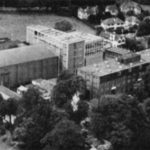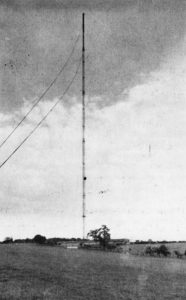London: The ITA’s transmitter at Croydon was opened on 22nd September 1955. It serves a population of 13 million in and around London. Programmes are provided by Associated-Rediffusion Ltd. (A-R) from Mondays to Fridays and by Associated TeleVision Ltd. (ATV) on Saturdays and Sundays.
The Midlands: The ITA’s transmitter at Lichfield was opened on 17th February 1956. It serves a population of 8¾ million. Programmes are provided by Associated TeleVision Ltd. (ATV) from Mondays to Fridays and by ABC Television Ltd. on Saturdays and Sundays.
The North: A population of 12½ million in Lancashire and Yorkshire is served by the ITA’s transmitters at Winter Hill and Emley Moor, opened in 1956. Programmes are provided by Granada TV Network Ltd. from Mondays to Fridays and by ABC Television Ltd. on Saturdays and Sundays. ITA Regional Officer: S. D. Murphy, Astley House, Quay Street, Manchester 3. Manchester Blackfriars 2707.
Scotland: THE ITA SCOTTISH COMMITTEE: Professor David Talbot Rice, M.B.E. (Chairman); Mr. Frank Donachy, O.B.E. 3 Mr. ]ohh Fergus, F.I.P.A.; The Rev. Arthur H. Gray; Dr. H. Stewart Mackintosh, C.B.E.; Sir William MacTaggart, P.R.S.A.; Mrs. T. N. Morgan; Miss Barbara L. Napier, J.P.; The Rev. Dr. W. A. Smellie.
Scotland is served by five of the ITA’s transmitters. A population of 4 million in Central Scotland is reached by the Black Hill station opened in 1957, the first after the three main areas had been covered. Programmes are provided by Scottish Television Ltd. (STV). North-East Scotland, with a population of 1.4 million, is served by the transmitters at Durris and Mounteagle, opened in 1961. Programmes are provided by Grampian Television Ltd. The southern borders of Scotland are served by the Caldbeck and Selkirk transmitters with programmes provided by Border Television Ltd. ITA Regional Officer for Scotland: John Lindsay, 147 West Regent Street, Glasgow C.2. Glasgow City 3130. (The Regional Officer for North-East England deals with the Border area.)
Wales and the West of England: THE ITA WELSH COMMITTEE: Mr. Jenkin Alban Davies, J.P. (Chairman); Dr. Ivor Davies; Miss Norah Isaac; Mrs. Enid Watkin ]ones; Mr. Thomas Ieuan Jeffrys Jones, M.A.; Major General Lewis Owain Pugh; Mr. Leslie Richards; The Rev. D. R. Thomas, M.A.
Two companies, TWW Ltd. and Wales (West & North) Ltd. (WWN), provide programmes for the Authority to broadcast to Welsh viewers. In addition to its responsibilities in South Wales, TWW also covers a wide area in the West of England; it provides programmes for the ITA’s transmitter at St. Hilary, opened in 1958, serving a population of 3.3 million. The technical difficulties of the area covered by Wales (West & North) Ltd. are indicated by the fact that three transmitters are needed in South-West, North-West and North-East Wales to broadcast its programmes to a population of about 1 million. These transmitters opened during 1962-63. ITA Regional Officer: L. J. Evans, Arlbee House, Greyfriars Place, Greyfriars Road, Cardiff. Cardiff 28759.
Southern England: Southern Television Ltd. provides programmes for Southern England from Kent to Dorset, an area which is not easily defined geographically or technically. The ITA’s transmitters at Chillerton Down on the Isle of Wight (opened in 1958) and at Dover (opened in 196O) serve a population of 4.3 million. ITA Regional Officer: Cmdr. G. W. Alcock, O.B.E., R.N. (Rtd.), 3o Portland Street, Southampton. Southampton 29115.
North-East England and Border Regions: The North-East of England, with programmes provided by Tyne Tees Television Ltd., is geographically, technically and socially well defined, consisting basically of the main part of the counties of Northumberland, Durham and the North Riding of Yorkshire. A population of 2.7 million is served from the ITAs transmitter at Burnhope, opened in 1959. Border Television Ltd. serves two nationalities as its area straddles the Anglo-Scottish border, its programmes being broadcast by one transmitter at Caldbeck and another at Selkirk in Scotland (opened 1961) to a population of nearly half a million. ITA Regional Officer: R. J. F. Larimer 32-4 Mosley Street, Newcastle-upon-Tyne. Newcastle 61-0148.
East Anglia: This was the first predominantly rural area in which the Independent Television Authority appointed a programme contractor, Anglia Television Ltd. This area is again both historically and geographically well defined. The topography of the area necessitated the first 1,000 ft. mast erected for the Authority, to serve a population of 2½ million. Programme operation commenced in 1959. ITA Regional Officer: Major General D. A. L. Wade, C.B., O.B.E., M.C., Century Insurance Building, 24 Castle Meadow, Norwich. Norwich 23533.
Northern Ireland: THE ITA ULSTER COMMITTEE: Sir Lucius O’Brien (Chairman); Mr. John G. Colhoun; Rev. Dr. C. B. Daly; Mr. G. B. Newe, O.B.E.; Mrs. G. Seth; Professor C. L. Wilson; The Rev. J. H. Withers.
The Province of Northern Ireland is served by two transmitters. The major one near the principal centre of population, the Belfast area, opened in 1959. The second, at Strabane in the west of the Province, opened early in 1963. Programmes are provided by Ulster Television Ltd. The population served is 1.4 million. ITA Regional Officer: W. H. Wilson, 5 Donegall Square South, Belfast. Belfast 3o818.
South-West England and the Channel Islands: Another geographically well-defined area is the South-West of England, consisting of the peninsula of Cornwall, Devon and parts of Somerset and Dorset. Westward Television Ltd. serves a population of 1.6 million from the ITA’s transmitters at Caradon Hill and Stockland Hill (opened in 1961). Programmes for the Channel Islands are provided by the smallest of all the fifteen ITV programme companies, Channel Television Ltd. Programme operation commenced during 1962. ITA Regional Officer: W. A. C. Collingwood, O.B.E., Royal London House, Armada Way, Plymouth. Plymouth 63031.




